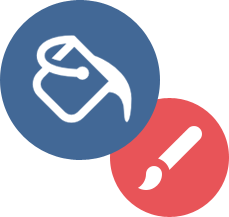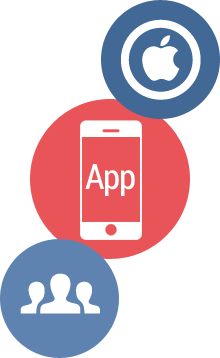Understanding the Process of App Development
Developmental phases of an app can be broken out into four major groups – developing a vision, creating a layout for functionality, designing the app, and launching the app.
1. The Beginning:
Developing a Vision

This is the stage when you will first begin to evaluate how an app will benefit your company and what you want that app to include. By creating a vision for your app, you can begin to mold the outcome of its development to ensure that you are satisfied with the end result. At this point, it is important to develop your idea in relation to how the app will provide value to your business and your customers. You can choose from several broad categories as you begin to decide what type of app you want to create: interactive, informational, game, etc. While simple apps will typically be less expensive and quicker to create, they may not become as popular as apps such as games that have the tendency to go viral. It may also be a good time to think about your budget and how much you plan to spend on the app so that you can discuss budgetary constraints with your app developer.

2. The Next Step:
Creating a Layout for Functionality
At this stage, it is best to avoid seeking out a programmer for help because in most cases, they won’t deliver what you want or need. Instead, take some time to go through the process to understand what will be involved and what you want your app to contain. You should make sure that you go through each step and each function of the app so that you will know what happens when each portion of the app is used. Even very simple apps often have a myriad of steps and processes that can be completed by the user.

3. Taking it to the Next Level:
Designing Your App
Apps, unlike other web based platforms, typically take an entire team of people to design and develop. Designers will typically begin to shape the aesthetics of the app once the basic functionality and layout have been defined with the programmer. After selecting key color schemes, themes, and designs for the app, the designer will send the finalized elements to the programmer, who will typically just drop them in the right places. Designing a beautiful and appealing app is one of the most important elements of the app development process so select a designer that can represent your brand in an appealing way. A few design elements that you will need to select include icons, splash screens, and all imagery needed to create a cohesive experience for the user.

4. The Launch:
Releasing Your App to the Public
Once the app has been built in xCode (Apple’s app development program), your developer can then help you launch it and release it to the public. As an illustration, launching an app via iTunes requires setting up an iTunes Connect account ($99/year) and then filling out the necessary information for the app including descriptions, pricing, icons, etc. Most of this process is intuitive once files are loaded, or you can have your technical team complete the whole process. The one-time setup fee also covers any additional apps that you want to upload, which is beneficial if you are launching a series of apps.
The great thing about iTunes Connect is that it also provides in-depth analytics that you can peruse any time to evaluate how many downloads your app has received, how many sales you’ve made, click through rates, etc. A variety of revenue models are used to drive sales through apps, and you can monitor it all right on your iTunes Connect dashboard. It may also be helpful to have a professional monitor your account so that you can use their insight to determine how to boost app sales and downloads.
